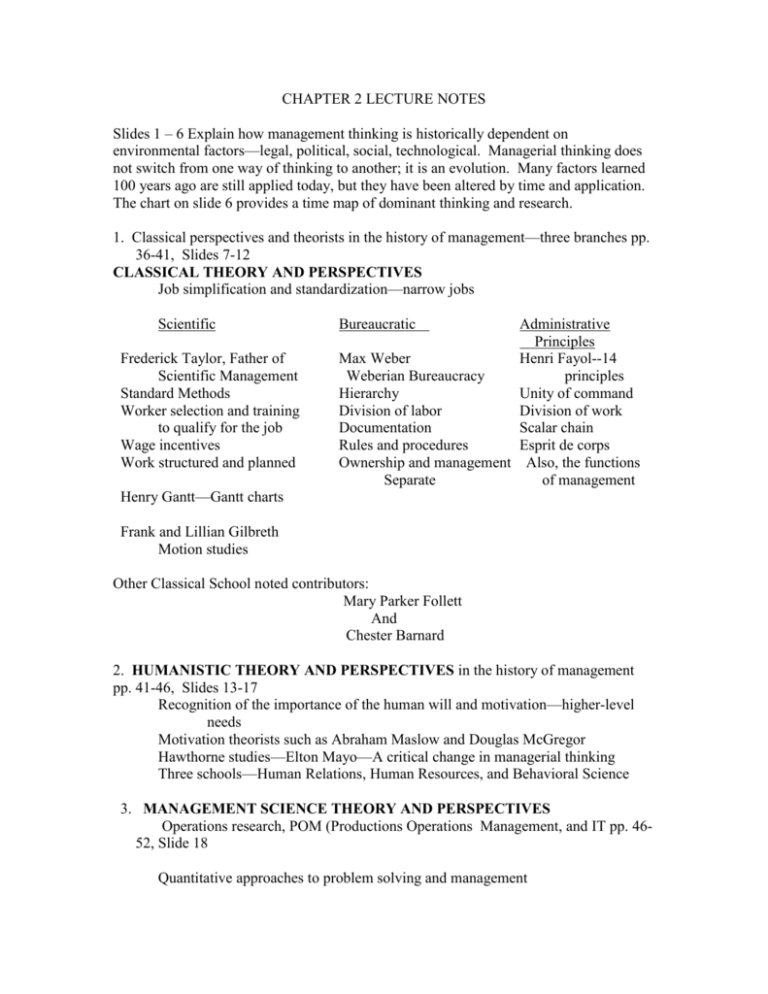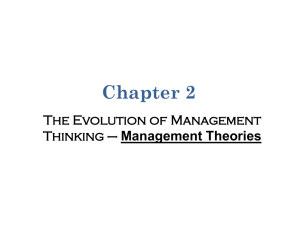CHAPTER 2 LECTURE NOTES
advertisement

CHAPTER 2 LECTURE NOTES Slides 1 – 6 Explain how management thinking is historically dependent on environmental factors—legal, political, social, technological. Managerial thinking does not switch from one way of thinking to another; it is an evolution. Many factors learned 100 years ago are still applied today, but they have been altered by time and application. The chart on slide 6 provides a time map of dominant thinking and research. 1. Classical perspectives and theorists in the history of management—three branches pp. 36-41, Slides 7-12 CLASSICAL THEORY AND PERSPECTIVES Job simplification and standardization—narrow jobs Scientific Frederick Taylor, Father of Scientific Management Standard Methods Worker selection and training to qualify for the job Wage incentives Work structured and planned Bureaucratic Administrative Principles Max Weber Henri Fayol--14 Weberian Bureaucracy principles Hierarchy Unity of command Division of labor Division of work Documentation Scalar chain Rules and procedures Esprit de corps Ownership and management Also, the functions Separate of management Henry Gantt—Gantt charts Frank and Lillian Gilbreth Motion studies Other Classical School noted contributors: Mary Parker Follett And Chester Barnard 2. HUMANISTIC THEORY AND PERSPECTIVES in the history of management pp. 41-46, Slides 13-17 Recognition of the importance of the human will and motivation—higher-level needs Motivation theorists such as Abraham Maslow and Douglas McGregor Hawthorne studies—Elton Mayo—A critical change in managerial thinking Three schools—Human Relations, Human Resources, and Behavioral Science 3. MANAGEMENT SCIENCE THEORY AND PERSPECTIVES Operations research, POM (Productions Operations Management, and IT pp. 4652, Slide 18 Quantitative approaches to problem solving and management Examples: production planning and scheduling—MRP (Materials Requirements Programs and Planning), inventory management, worker scheduling Queuing theory, linear programming Information technologies commencing with the historic Hollerith Code (U.S. Census Bureau) and the 80-column card Statistical process control and other quality management techniques 4. RECENT TRENDS IN MANAGERIAL THINKING—Modern School/Contemporary Management Focus pp. 47-52, Slides 19-25 Open systems Theory Contingency and Situational management and leadership TQM (several quality management programs) The Learning Organization The Technologically driven workplace, including e-business and commerce It is important to remember that although each of the five eras of management is distinctive, the history of management is an evolution. Classical thinking did not stop, nor did humanistic focus; instead, thinking was augmented by new research. The importance of contingency and situational thinking is that all historic approaches may be appropriate in certain situations. Management science is used in addition to other methods of problem solving. Understanding the variables of different situations is the management and leadership skill recognized today as being important. Judgment is the critical factor and may be replacing the need for rules, regulations, and procedures in some situations. 5. The Open Systems Theory/Concepts pp. 47 The following model is another version of the model in the textbook. It emphasizes the importance of “outcomes” by separating them from “outputs.” Also, workers are an element of “Resource Conversion,” rather than “inputs.” The pool of potential employees from which employees are selected are “inputs.” Neither model is the correct or incorrect display of the concepts, rather it is two different ways of viewing organizations, departments, and jobs within a complex environment. An organization’s need to interact with the environment is why the system is considered to be “open.” Resource Conversion Inputs People Equipment (capital goods) Procedures Outputs Outcomes Work Feedback Open Systems Theory Meeting Specifications 100% time with outputs and meeting or exceeding customers’ expectations constitutes quality and effectiveness. Achieving this at the lowest cost (least resources) is efficiency. Productivity= effectiveness + efficiency











